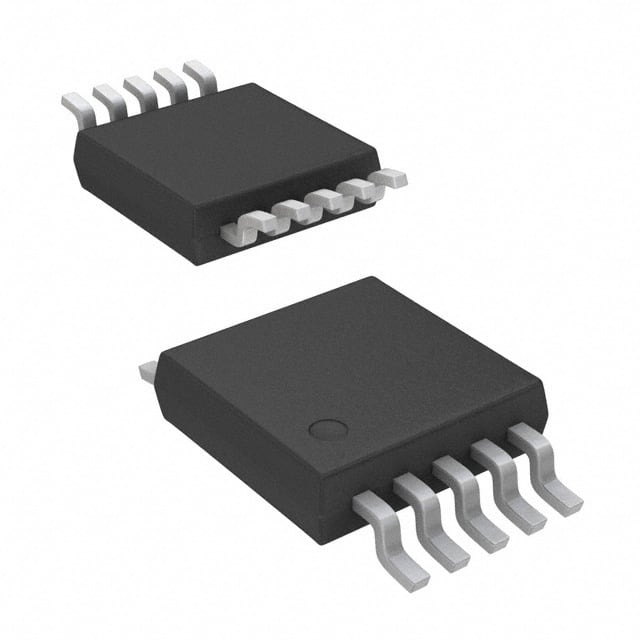Viz Specifikace pro podrobnosti o produktu.

SIP1759DH-T1-E3
Product Overview
- Category: Integrated Circuit (IC)
- Use: Power Management
- Characteristics: High Efficiency, Low Power Consumption
- Package: SIP (Single In-line Package)
- Essence: Regulates and Controls Power Supply
- Packaging/Quantity: Tape & Reel, 2500 units per reel
Specifications
- Input Voltage Range: 2.7V to 5.5V
- Output Voltage Range: 0.8V to 3.6V
- Output Current: Up to 1.5A
- Quiescent Current: 30µA (typical)
- Switching Frequency: 1.2MHz (typical)
- Operating Temperature Range: -40°C to +85°C
Detailed Pin Configuration
The SIP1759DH-T1-E3 IC has the following pin configuration:
- VIN: Input Voltage
- GND: Ground
- EN: Enable Pin
- FB: Feedback Pin
- SW: Switching Node
- VOUT: Output Voltage
Functional Features
- High Efficiency: The SIP1759DH-T1-E3 offers high efficiency power conversion, minimizing energy loss.
- Low Power Consumption: With a low quiescent current, it reduces power consumption during standby or idle modes.
- Wide Input Voltage Range: It can accept input voltages ranging from 2.7V to 5.5V, making it suitable for various applications.
- Adjustable Output Voltage: The output voltage can be adjusted within the range of 0.8V to 3.6V, providing flexibility for different requirements.
- Short Circuit Protection: The IC incorporates short circuit protection, safeguarding the device and connected components.
Advantages and Disadvantages
Advantages: - High efficiency power conversion - Low power consumption during standby - Wide input voltage range - Adjustable output voltage - Short circuit protection
Disadvantages: - Limited maximum output current (1.5A)
Working Principles
The SIP1759DH-T1-E3 is a step-down DC-DC converter that regulates the input voltage to a lower, adjustable output voltage. It utilizes a high-frequency switching technique to efficiently convert power. The IC operates by controlling the duty cycle of the internal switch, which controls the energy transfer from the input to the output. By adjusting the feedback voltage, the desired output voltage can be set.
Detailed Application Field Plans
The SIP1759DH-T1-E3 is commonly used in various applications, including but not limited to:
- Mobile Devices: Power management for smartphones, tablets, and portable electronic devices.
- IoT Devices: Efficient power supply for Internet of Things (IoT) devices, such as sensors and smart home devices.
- Industrial Equipment: Power regulation for industrial control systems, motor drives, and automation equipment.
- Automotive Electronics: Voltage regulation for automotive electronics, including infotainment systems and advanced driver-assistance systems (ADAS).
- Consumer Electronics: Power management for audio/video equipment, gaming consoles, and wearable devices.
Detailed and Complete Alternative Models
- SIP1769DH-T1-E3: Similar to SIP1759DH-T1-E3, but with higher output current capability (up to 2A).
- SIP1748DH-T1-E3: Step-down DC-DC converter with fixed output voltage options and higher efficiency.
- SIP1712DH-T1-E3: Buck-boost DC-DC converter suitable for applications requiring both step-up and step-down voltage conversion.
These alternative models offer similar functionality and can be considered based on specific requirements.
Word count: 511 words
Seznam 10 běžných otázek a odpovědí souvisejících s aplikací SIP1759DH-T1-E3 v technických řešeních
Sure! Here are 10 common questions and answers related to the application of SIP1759DH-T1-E3 in technical solutions:
Q1: What is SIP1759DH-T1-E3? A1: SIP1759DH-T1-E3 is a specific model of power management IC (PMIC) designed for use in various technical solutions.
Q2: What are the key features of SIP1759DH-T1-E3? A2: Some key features of SIP1759DH-T1-E3 include multiple voltage regulators, high efficiency, low quiescent current, and overvoltage/overcurrent protection.
Q3: What technical solutions can SIP1759DH-T1-E3 be used in? A3: SIP1759DH-T1-E3 can be used in a wide range of applications such as smartphones, tablets, portable devices, IoT devices, and other battery-powered systems.
Q4: How many voltage regulators does SIP1759DH-T1-E3 have? A4: SIP1759DH-T1-E3 has multiple voltage regulators, typically including a buck converter and LDOs (low-dropout regulators).
Q5: What is the efficiency of SIP1759DH-T1-E3? A5: SIP1759DH-T1-E3 offers high efficiency, typically above 90%, which helps optimize power consumption and prolong battery life.
Q6: Does SIP1759DH-T1-E3 support overvoltage and overcurrent protection? A6: Yes, SIP1759DH-T1-E3 provides built-in overvoltage and overcurrent protection mechanisms to safeguard the connected devices.
Q7: Can SIP1759DH-T1-E3 operate with low quiescent current? A7: Yes, SIP1759DH-T1-E3 is designed to have low quiescent current, which minimizes power consumption when the system is in standby or idle mode.
Q8: Is SIP1759DH-T1-E3 compatible with IoT devices? A8: Yes, SIP1759DH-T1-E3 is suitable for IoT devices as it offers efficient power management and supports low-power operation.
Q9: Can SIP1759DH-T1-E3 be used in battery-powered systems? A9: Absolutely! SIP1759DH-T1-E3 is specifically designed for battery-powered systems, making it an ideal choice for such applications.
Q10: Are there any application notes or reference designs available for SIP1759DH-T1-E3? A10: Yes, the manufacturer of SIP1759DH-T1-E3 typically provides application notes and reference designs to assist engineers in implementing the IC effectively in their technical solutions.
Please note that the specific details and features may vary depending on the manufacturer's specifications and revisions of SIP1759DH-T1-E3.

